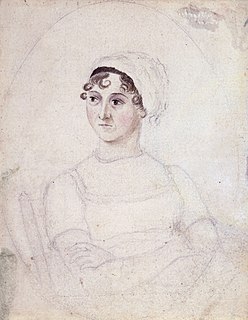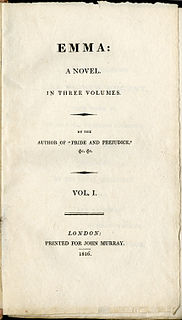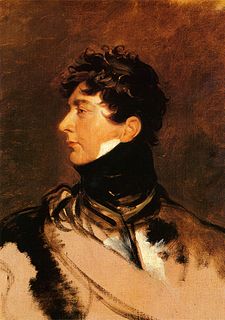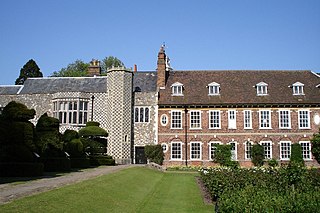Related Research Articles

Jane Austen was an English novelist known primarily for her six major novels, which interpret, critique and comment upon the British landed gentry at the end of the 18th century. Austen's plots often explore the dependence of women on marriage in the pursuit of favourable social standing and economic security. Her works critique the novels of sensibility of the second half of the 18th century and are part of the transition to 19th-century literary realism. Her use of biting irony, along with her realism, humour, and social commentary, have long earned her acclaim among critics, scholars, and popular audiences alike.

Pride and Prejudice is a romantic novel of manners written by Jane Austen in 1813. The novel follows the character development of Elizabeth Bennet, the dynamic protagonist of the book who learns about the repercussions of hasty judgments and comes to appreciate the difference between superficial goodness and actual goodness. Its humour lies in its honest depiction of manners, education, marriage, and money during the Regency era in Great Britain.

Northanger Abbey is a coming-of-age novel and a satire of Gothic novels written by Jane Austen. It was completed for publication in 1803, making it the first of Austen's novels in order of completion, but was only published posthumously in 1817 with another of her novels, Persuasion. The story revolves around Catherine Morland, the young and naïve "heroine", and her journey to a better understanding of herself and the world around her.

Emma, by Jane Austen, is a novel about youthful hubris and romantic misunderstandings. It is set in the fictional country village of Highbury and the surrounding estates of Hartfield, Randalls, and Donwell Abbey and involves the relationships among people from a small number of families. The novel was first published in December 1815, with its title page listing a publication date of 1816. As in her other novels, Austen explores the concerns and difficulties of genteel women living in Georgian–Regency England. Emma is a comedy of manners, and depicts issues of marriage, sex, age, and social status.

The Regency in the United Kingdom of Great Britain and Ireland was a period at the end of the Georgian era, when King George III was deemed unfit to rule due to his illness, and his son ruled as his proxy, as prince regent. Upon George III's death in 1820, the prince regent became King George IV. The term Regency can refer to various stretches of time; some are longer than the decade of the formal Regency which lasted from 1811 to 1820. The period from 1795 to 1837, which includes the latter part of George III's reign and the reigns of his sons George IV and William IV, is sometimes regarded as the Regency era, characterised by distinctive trends in British architecture, literature, fashions, politics, and culture.

Persuasion is the last novel fully completed by Jane Austen. It was published at the end of 1817, six months after her death.
"The British Poetry Revival" is the general name given to a loose poetry movement in Britain that took place in the 1960s and 1970s. The revival was a modernist-inspired reaction to the Movement's more conservative approach to British poetry. The poets included an older generation - Bob Cobbing, Paula Claire, Tom Raworth, Eric Mottram, Jeff Nuttall, Andrew Crozier, Lee Harwood, Allen Fisher, Iain Sinclair - and a younger generation: Paul Buck, Bill Griffiths, John Hall, John James, Gilbert Adair, Lawrence Upton, Peter Finch, Ulli Freer, Ken Edwards, Robert Gavin Hampson, Gavin Selerie, Frances Presley, Elaine Randell, Robert Sheppard, Adrian Clarke, Clive Fencott, Maggie O'Sullivan, Cris Cheek, Tony Lopez and Denise Riley.

221B Baker Street is the London address of the fictional detective Sherlock Holmes, created by author Sir Arthur Conan Doyle. In the United Kingdom, postal addresses with a number followed by a letter may indicate a separate address within a larger, often residential building. Baker Street in the late 19th century was a high-class residential district, and Holmes' apartment would probably have been part of a Georgian terrace.
The I-SPY books are spotters' guides written for British children, and particularly successful in the 1950s and 1960s in their original form and again when relaunched by Michelin in 2009 after a seven-year gap in publishing.
Abbey National plc was a bank based in the United Kingdom and former building society, which latterly traded under the Abbey brand name.

Hall Place is a stately home in the London Borough of Bexley in south-east London, built in 1537 for Sir John Champneys, a wealthy merchant and former Lord Mayor of London. The house was extended in 1649 by Sir Robert Austen, a merchant from Tenterden in Kent. The house is a Grade I listed building and Scheduled Ancient Monument, and surrounded by a 65-hectare award-winning garden. It is situated on the A223, Bourne Road, south of Watling Street (A207) and north of the 'Black Prince' interchange of the A2 Rochester Way and the A220.

The Sherlock Holmes Museum is a privately run museum in London, England, dedicated to the famous fictional detective Sherlock Holmes. It is the world's first museum dedicated to the literary character Sherlock Holmes. It opened in 1990 and is situated in Baker Street, bearing the number 221B by permission of the City of Westminster, although it lies between numbers 237 and 241, near the north end of Baker Street in central London close to Regent's Park.
Austen Kark CBE was a managing director of the BBC World Service. He was one of three former holders of that post, along with Gerard Mansell and John Tusa, to oppose the plans of John Birt to merge the service into the BBC. After Birt became director general of the BBC in 1992, he had planned to end the service's independent status at Bush House in central London, and absorb it within the rest of the corporation.

Moody Street Irregulars was an American publication dedicated to the history and the cultural influences of Jack Kerouac and the Beat Generation. Edited and published by Joy Walsh, it featured articles, memoirs, reviews and poetry. Published from Clarence Center, New York, it had a run of 28 issues from Winter 1978 to 1992. Some issues were edited by Walsh with Michael Basinski and Ana Pine.

The Sherlock Holmes is a Victorian era themed public house in Northumberland Street near Charing Cross railway station and Trafalgar Square which contains a large collection of memorabilia related to the fictional detective Sherlock Holmes. The original collection was put together for display in Baker Street in London during the Festival of Britain in 1951.

The Old Orchard Street Theatre in Bath, Somerset, England was built as a provincial theatre before becoming a Roman Catholic Church and since 1865 has been a Masonic Hall. It is a Grade II listed building.

"Disguise for Murder" is a Nero Wolfe mystery novella by Rex Stout, first published as "The Twisted Scarf" in the September 1950 issue of The American Magazine. It first appeared in book form in the short-story collection Curtains for Three, published by the Viking Press in 1951.

A statue of Sherlock Holmes by the sculptor John Doubleday stands near the supposed site of 221B Baker Street, the fictional detective's address in London. Unveiled on 23 September 1999, the sculpture was funded by the Abbey National building society, whose headquarters were on the purported site of the famous address. As no site was available on Baker Street itself the statue was installed outside Baker Street tube station, on Marylebone Road. Doubleday had previously produced a statue of Holmes for the town of Meiringen in Switzerland, below the Reichenbach Falls whence the detective fell to his apparent death in the story "The Final Problem".

Reading Abbey Girls' School, also known as Reading Ladies’ Boarding School and other similar names, achieved notability in the nineteenth century. The St Quentins, a husband and wife team, were associated with several girls' schools in the late 18th and early 19th centuries. Many of their pupils went on to make a mark on English culture and society, particularly as writers. The most famous was Jane Austen, who used their school in Reading, Berkshire as a model of "a real, honest, old-fashioned Boarding-school".
The Wolfe Pack is a literary society devoted to Rex Stout's character Nero Wolfe.
References
- 1 2 London Mystery Magazine/Selection Checklist
- ↑ Hedunit - TIME
- ↑ Scott-Farley, Jonathan. "London Mystery Home Page" . Retrieved July 13, 2015.
- ↑ London Mystery Magazine/Selection
- ↑ Obituary: Austen Kark | Media | The Guardian